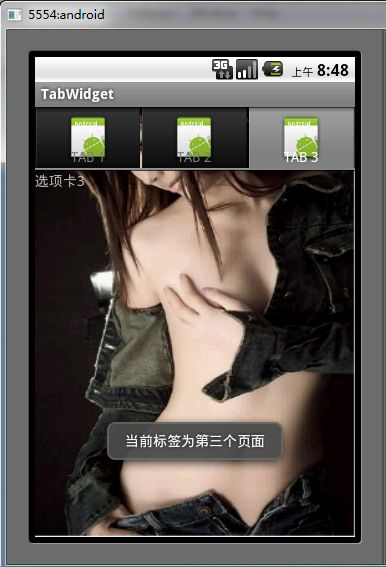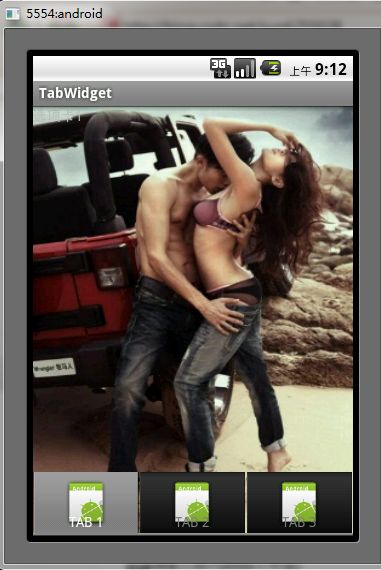Android控件开发之TabWidget
/**
* Tab选项卡类似与电话本的界面,通过多个标签切换不同的内容,要实现这个效果,首先要知道TabHost,
* 它是一个用来存放多个Tab标签的容器,每一个Tab都可以对应自己的布局,比如,电话本中的Tab布局就
* 是一个线性布局
* 要使用TabHost,首先要通过getTabHost方法获取TabHost的对象,然后通过addTab方法来向
* TabHost中添加Tab,当然每个Tab在切换时都会产生一个事件,要捕捉这个事件,需要设置TabActivity
* 的事件监听setOnTabChangedListener
*/
效果图
发现很多微薄如腾讯,新浪的选项卡 都是显示在页面底部的,网上有资料:通过反射获取tabwidget中的私有变量,改变其值。
<!-- 实现Tab标签的居底主要是通过设置属性 android:layout_weight="1" -->
<!-- 还要注意FrameLayout标签的位置,要写在TabWidget标签的前面 -->
效果图
本程序main.xml源码
<?xml version="1.0" encoding="utf-8"?> <TabHost xmlns:android="http://schemas.android.com/apk/res/android" android:id="@android:id/tabhost" android:layout_width="fill_parent" android:layout_height="fill_parent"> <LinearLayout android:orientation="vertical" android:layout_width="fill_parent" android:layout_height="fill_parent"> <!-- 实现Tab标签的居底主要是通过设置属性 android:layout_weight="1" --> <!-- 还要注意FrameLayout标签的位置,要写在TabWidget标签的前面 --> <FrameLayout android:id="@android:id/tabcontent" android:layout_weight="1" android:layout_width="fill_parent" android:layout_height="fill_parent" /> <TabWidget android:id="@android:id/tabs" android:layout_alignParentBottom="true" android:layout_width="fill_parent" android:layout_height="wrap_content" /> </LinearLayout> </TabHost>
java源码
import android.app.TabActivity;
import android.os.Bundle;
import android.widget.TabHost;
import android.widget.Toast;
import android.widget.TabHost.OnTabChangeListener;
public class TabWidgetActivity extends TabActivity
{
TabHost tabhost;
@Override
public void onCreate(Bundle savedInstanceState)
{
super.onCreate(savedInstanceState);
setContentView(R.layout.main);
//取得TabHost对象
tabhost = getTabHost();
//为TabHost添加标签
//新建一个newTabSpec(newTabSpec)
//设置其标签和图标(setIndicator)
//设置内容(setContent)
tabhost.addTab(tabhost.newTabSpec("tab1")
.setIndicator("TAB 1",getResources().getDrawable(R.drawable.icon))
.setContent(R.id.text1));
tabhost.addTab(tabhost.newTabSpec("tab2")
.setIndicator("TAB 2",getResources().getDrawable(R.drawable.icon))
.setContent(R.id.text2));
tabhost.addTab(tabhost.newTabSpec("tab3")
.setIndicator("TAB 3",getResources().getDrawable(R.drawable.icon))
.setContent(R.id.text3));
//设置TabHost的背景颜色
//tabhost.setBackgroundColor(Color.argb(150,22,70,150));
//设置TabHost的背景图片资源
tabhost.setBackgroundResource(R.drawable.bg0);
//设置当前显示哪个标签
tabhost.setCurrentTab(0);
//标签切换事件处理,setOnTabChangedListener
tabhost.setOnTabChangedListener(new OnTabChangeListener()
{
public void onTabChanged(String tabId)
{
switch(tabhost.getCurrentTab())
{
case 0:
tabhost.setBackgroundResource(R.drawable.bg0);
Toast.makeText(getApplicationContext(), "当前标签为第一个页面", Toast.LENGTH_SHORT).show();
break;
case 1:
tabhost.setBackgroundResource(R.drawable.bg1);
Toast.makeText(getApplicationContext(), "当前标签为第二个页面", Toast.LENGTH_SHORT).show();
break;
case 2:
tabhost.setBackgroundResource(R.drawable.bg2);
Toast.makeText(getApplicationContext(), "当前标签为第三个页面", Toast.LENGTH_SHORT).show();
break;
}
}
});
}
}

